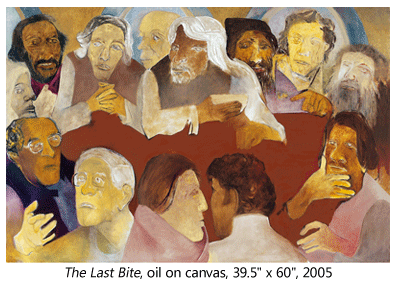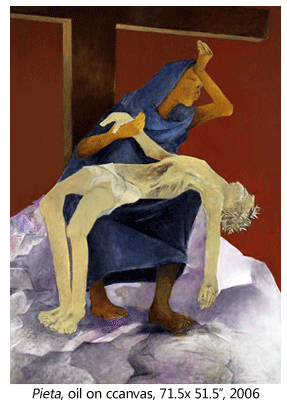- Prelude
- Editorial
- A Conversation with Jagdish Swaminathan
- Seeing is Very Important………
- Tormented Delineations and Violent Deformations
- Bikash Bhattacharjee: Subverting the Seen
- Bridging Western and Indian Modern Art: Francis Newton Souza
- Contesting National and the State: K K Hebbar's Modernist Project
- The Allegory of Return into the Crucial Courtyard
- Knowing Raza
- The Old Story Teller
- Beautiful and Bizarre: Art of Arpita Singh
- Feeling the Presence in Absence! Remembering Prabhakar Barwe
- Waterman's Ideal Fountain Pen
- Peepli Live: the Comic Satire Stripping off the Reality of Contemporary India
- Age of Aristocracy: Georgian Furniture
- Faking It - Our Own Fake Scams
- Scandalous Art and the “Global” Factor
- The Composed and Dignified Styles in Chinese Culture
- Visual Ventures into New Horizons: An Overview of Indian Modern Art Scenario
- The Top, Middle and Bottom Ends
- Top 5 Indian Artists by Sales Volume
- What Happened and What's Forthcoming
- The Month that was
- NESEA : A Colourful Mosaic
- Mumbai Art Sighting
- Art Events Kolkata
- Musings from Chennai
- Art Bengaluru
- Khoj, Kolkata Boat Project
- What a Summit!
- Ganesh Haloi at Art Motif
- The Other Self by Anupam Sud at Art Heritage, New Delhi
- Baul Fakir Utsav at Jadavpur
- Printmaking Workshop
- World's Greatest Never Before Seen Toy and Train Collection
- Previews
- In the News
- Christies: Jewellery Auction at South Kesington, London
ART news & views
The Old Story Teller
Volume: 3 Issue No: 13 Month: 2 Year: 2011
by Uma Prakash
IKrishen Khanna breathes life into his images with the stroke of his brush evoking human situations with matchless brilliance. His protagonists are usually the common folks in the street whom he portrays with a rare sensitivity. He has featured them in his oeuvre of work from his truck series, Christ's plight, and refugee's predicament to the Bandwallas. It is Khanna's empathy for the weak and underprivileged that emerges in most of his compositions.
Born in Lyallpur (now Faislabad, Pakistan), in pre- partition India in 1925, Khanna moved to Shimla during the partition. His only formal study of art was at the Imperial Services College in Windsor, London and later joined Sheikh Ahmed's Studio One in Lahore to study drawing. Although his early childhood memories of Lahore invariably found their way to his canvases like The Old Story Teller in 1989 it was his move to India from Pakistan during the partition that really impacted him. So imbedded was the brutal exodus in the young artist's mind that even after over sixty years the artist was compelled to paint Refugees 1947 in 2009.  Portraying the ravages of partition it features an old man holding a lantern, with children, women and animals all striding towards a strange destination and a future unknown … It made him recall the opening lines of C Day-Lewis's poem, Departure in the Dark-“Nothing so sharply reminds a man that he is mortal / As leaving a place/ In a winter morning's dark...”. (Saffronart presents Krishen Khanna A Retrospective 2010) Moreover it is his expressionistic brush work and vivid colors that is unique in this recent work.
Portraying the ravages of partition it features an old man holding a lantern, with children, women and animals all striding towards a strange destination and a future unknown … It made him recall the opening lines of C Day-Lewis's poem, Departure in the Dark-“Nothing so sharply reminds a man that he is mortal / As leaving a place/ In a winter morning's dark...”. (Saffronart presents Krishen Khanna A Retrospective 2010) Moreover it is his expressionistic brush work and vivid colors that is unique in this recent work.
After arriving in India he joined Grindlays Bank and was posted in Mumbai where he continued to paint. He received recognition for his painting News of Gandhijis's Death in 1948 which was part of the Bombay Art Society's Golden Jubilee Exhibition. Khanna was invited to join the Progressive Artists' Group with whose members he shared a great affinity. The Progressive Artists' Group founded by Francis Newton Souza had leftist leanings, as they rejected the nationalist art of the Bengal School and embraced international modern art practices. They were determined to create their own visual language. The other members were SH Raza, Tyeb Mehta, VS Gaitonde, Krishen Khanna, Akbar Padamsee, Ram Kumar, Bal Chabda, MF Husain, KH Ara, SK Bhakre and HA Gade.
His bond with his contemporaries was evident in The Last Bite (2005) where he humorously recreates the Last Supper featuring many of these artists. It evokes memories of their informal tea sessions enjoyed over the years. Khanna endorses MF Husain's significant contribution to Indian art by positioning him in the place of Christ. By including J Swaminathan, Bupen Khakkar, Manjit Bawa and Jogen Chowdhury he includes artists with different views and attitudes who contributed to Indian modernism. The painting also contains Bhanu Athaiya the only woman member of the Progressives.
“All great art has to be local. When I say local, I mean an artist has to draw from the things near him so that a certain passion comes through in his paintings. At the same time, great art transcends the ordinary moment and strikes a moment in infinity” (Gayatri Sinha, Krishen Khanna- A critical biography, Vadehra Art Gallery, New Delhi,  2001, p 134,135)
2001, p 134,135)
His Rear View (2003) and Conversations in a Dhaba (2009) confirm these sentiments as he captures moments from the lives of the locals who are an integral part of his surroundings. In Rear View the artist shifts from his own voyage to the nomadic migrant worker's journey. Khanna articulates the plight of the poor labourers traveling in an open truck in the hot and dusty streets of the city in somber colours. The artist reveals the hardships encountered by the protagonists, as they lie dangerously on iron pipes and rods, trying desperately to shield themselves from the scorching sun, by covering themselves with their clothes. Through his painterly artistic skill Khanna manages to elevate the mundane to an emotional level.
The artist's pre-occupation with the life of simple people in a commonplace dhaba or tea stall is deftly illustrated in Conversations at a Dhaba (2009). Through the sheer vibrancy of his images Khanna brings to life the energy, intrigue and humour inside a dhaba. The little group of migrants get together to exchange happenings of the day, escaping from the biting cold and adversity that awaits them outside.
From the labourers to the Bandwallas, Khanna's visual vocabulary conveys his deep concern for the state and fate of man in the modern context. Divined in his own visual language Khanna's interpretation of Bandwallas (2000) is unique. He has captured the band in its most sad and bizarre state. Playing alone or in a group, they make a statement. Often associated with majestic army bands the motley bands, dressed in worn out uniforms, elevate the middleclass gentry's sense of gaiety by accompanying marriage processions in the city. The artist has caught them rehearsing or saddled in a tempo with all set to reach their place of performance. The Band is a means of survival for the bandwallas who earn their livelihood by playing joyous music for the pleasure of others. They hold a special place for the artist who has often reflected on their lives while depicting them in different situations.
Besides the bandwallas Khanna was fascinated with the life of Christ. This interest dates to his childhood when at the age of seven he was shown a print of Leonardo's The Last Supper.  As a young child he tried to copy it revealing his first inclination to the arts. The image stayed imprinted in his mind and he depicted Christ frequently in his work. The artist's Christ was minus a halo as he had made him as humane as possible quite on the lines of the usual work force and labourers. Pieta painted in 1988 moves from shades of blue, a touch of purple, to the slightest whisper of grey. Khanna has captured the moment of spiritual revelation between Mary and Christ. Although both the narratives bear similar emotions the same subject painted in 2006 reveals a boldness in color with a stark brown background which stand out in contrast to the blue.
As a young child he tried to copy it revealing his first inclination to the arts. The image stayed imprinted in his mind and he depicted Christ frequently in his work. The artist's Christ was minus a halo as he had made him as humane as possible quite on the lines of the usual work force and labourers. Pieta painted in 1988 moves from shades of blue, a touch of purple, to the slightest whisper of grey. Khanna has captured the moment of spiritual revelation between Mary and Christ. Although both the narratives bear similar emotions the same subject painted in 2006 reveals a boldness in color with a stark brown background which stand out in contrast to the blue.
Khanna's preoccupation with Christ continues with The Betrayal (2006), which reveals the artist as an absolutely master draughtsman. His minimum use of color speaks volumes for his inimitable style and technique. Judas's kiss and Jesus's attempt to hold him back is a perfect study of human nature. Even though he is focusing on Judas's betrayal the artist seems to address the treachery that exists among people in a universal sense. His visually challenging piece is dramatized in different shades of white.
The artist uses hues of white in strong contrast with black to create a chilling drama in The Anatomy Lesson (1972). This visually riveting work glides from the bright to the dark to grasp the viewer's attention. The austere military figures in peaked hats are studying a body wrapped in pale shroud lying like a corpse.  The artist's sensitivity and lyrical flow of lines arrests the grim situation, displaying the power of establishment over lesser mortals.
The artist's sensitivity and lyrical flow of lines arrests the grim situation, displaying the power of establishment over lesser mortals.
In 1961 Khanna resigned from his Grindlays Bank job to focus full time on art. The Rockefeller Fellowship in 1962 took him to Japan exposing him to the Sumi-e practice, an ancient form of Chinese calligraphy. He implemented it in his body of abstract work on rice paper. He subsequently became the Artist in Residence at the American University in Washington in 1963-64. Apart from several one man shows he has participated in prestigious shows like the Tokyo Biennale 1957 and 1961, the Sao Paulo Biennale 1960, the Venice Biennale 1962, the Festival of India in the then USSR and in Japan in 1987 and 1988. Khanna's contribution to institutes like Lalit Kala Akademi, National Gallery of Modem Art and Roopanker Museum, Bhopal have been significant. He was awarded the Padma Shri in 1996.
A significant work of Khanna is The Great Procession commissioned for the dome of the lobby in the ITC hotel in Delhi where he has created the life lived by the common man on the street.
Khanna sees the world through colours executing a visual narrative that has a wide appeal. Through his mastery of his medium he transports the viewer's visual senses to another world. The artist's creative energy explodes on the canvas as he manipulates his powerful brush, often using the palette knife, to create exquisite paintings that will remain firmly entrenched in the viewer's mind.